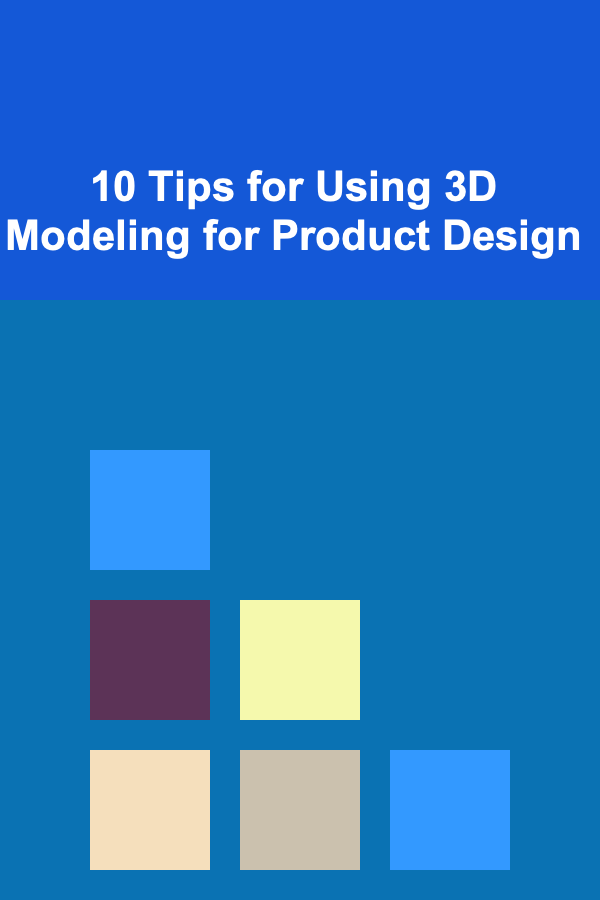
10 Tips for Using 3D Modeling for Product Design
ebook include PDF & Audio bundle (Micro Guide)
$12.99$11.99
Limited Time Offer! Order within the next:

3D modeling has revolutionized the world of product design, enabling designers and engineers to visualize, test, and perfect their concepts before they hit the production line. Whether you're working on a consumer product, machinery, or even prototypes for new technology, 3D modeling offers a wealth of advantages that can enhance both the design process and the final product. It allows for rapid prototyping, clearer communication with stakeholders, and the ability to detect design flaws early in the process.
In this article, we'll explore ten key tips to help you use 3D modeling effectively in product design. By incorporating these practices into your workflow, you'll be able to streamline your process, increase efficiency, and produce better-quality products.
Start with a Clear Concept and Plan
Before jumping into any 3D software, it's crucial to have a well-defined concept for your product. A clear vision and plan help you focus on what needs to be accomplished, saving time and reducing unnecessary changes later on in the process. The planning phase involves understanding the product's purpose, target audience, and technical requirements.
To help you visualize your idea, sketching your product or creating low-fidelity wireframes can act as a blueprint for your 3D model. A rough sketch allows you to outline the basic shape, form, and functionality of the product before committing to the details in your 3D modeling software.
Tip: Develop a product brief that includes the product's functionality, size, intended materials, and other specifications. This document will be the guiding reference throughout the 3D modeling process, ensuring you stay on track and avoid deviating from the initial concept.
Choose the Right 3D Modeling Software
Selecting the right 3D modeling software is one of the most important decisions you'll make. The software you choose will influence the design process, efficiency, and the capabilities available to you during development. There are a variety of 3D modeling programs, each offering unique features suited to different types of product design. Here are some options:
- SolidWorks: A popular choice for mechanical engineers and product designers, SolidWorks offers parametric design capabilities and is ideal for creating parts and assemblies.
- Rhinoceros (Rhino): Known for its versatility in designing complex and organic shapes, Rhino is widely used in industrial design, jewelry, and architecture.
- Fusion 360: Ideal for product designers and engineers, Fusion 360 is cloud-based and provides a collaborative environment for design, simulation, and manufacturing.
- Blender: While primarily used for animation and visual effects, Blender also has strong modeling tools that are useful for product design, especially in more artistic industries like consumer electronics and fashion.
Tip: Choose software based on the complexity of your product and your familiarity with the tool. If you're designing mechanical parts, SolidWorks or Fusion 360 may be ideal, while Rhino or Blender could be better suited for more organic or artistic designs.
Use Parametric Design for Flexibility
Parametric design refers to the process of creating 3D models where the geometry is controlled by parameters or variables. This allows you to make quick adjustments to the design by modifying the parameters instead of manually altering each component. It's an essential feature for product design because it offers flexibility and allows you to make changes without starting from scratch.
For instance, if you're designing a product with adjustable components, like a custom enclosure or a mechanical system, using parametric modeling can help you adjust the dimensions, proportions, or assembly details without needing to rebuild the model each time.
Tip: When creating parts that need to fit together or share dimensions, use parametric features to ensure that adjustments to one component will automatically update others that depend on it. This reduces errors and speeds up iterations.
Incorporate Real-World Materials and Textures
3D modeling isn't just about form and function; it's also about how the product will look and feel in the real world. One of the best ways to visualize how your product will appear is by incorporating real-world materials and textures into your model. Many 3D software programs offer realistic rendering options that allow you to apply various material finishes, such as metal, plastic, glass, and fabric.
By simulating these materials, you can better understand how light will interact with the surfaces of your design, helping you fine-tune the aesthetic and functionality of your product. This step is particularly useful when presenting designs to stakeholders, as it provides a more realistic preview of the final product.
Tip: Use high-quality texture maps and material properties to simulate different finishes (matte, glossy, metallic, etc.). This can help you spot design flaws, like unrealistic reflections or awkward textures, before moving to physical prototypes.
Ensure Accurate Scale and Proportions
Accurate scale and proportions are fundamental to product design. Inaccurate dimensions can cause significant problems, such as poor ergonomics or parts that do not fit together as intended. One of the advantages of 3D modeling is that you can precisely control and adjust the scale of your design from the very beginning.
Using software tools, you can measure and adjust the dimensions of each part in real time, ensuring that your model meets the required specifications. Be sure to check the proportions of your model relative to human scale (for consumer products) or other relevant metrics, depending on the nature of your design.
Tip: Use the measurement and dimensioning tools in your 3D software to double-check your work. In addition, try to simulate how the product will interact with users in its physical environment to ensure it is not only accurate but functional.
Consider Tolerances and Fit
When designing mechanical products or parts that need to fit together, tolerances become critical. Tolerances refer to the acceptable limits of variation in a part's size, which is essential when designing components that will be assembled together. A part that is too tight or too loose can lead to failure, especially in mass production.
Incorporate tolerance calculations into your 3D model, paying close attention to the gaps between moving parts, threaded areas, and other critical connection points. Most advanced 3D modeling software allows you to specify tolerances, ensuring your design is feasible for manufacturing.
Tip: Use engineering drawings and specifications to outline acceptable tolerances and incorporate them into your 3D model. This ensures that your design can be manufactured accurately and assemble correctly.
Test and Simulate Performance
Before committing to the production stage, it's essential to test how your product will perform in the real world. Many 3D modeling programs come with built-in simulation tools that allow you to test the mechanical, thermal, and structural properties of your design. For example, you can simulate how the product will hold up under stress, how materials will behave at different temperatures, or how components will interact during use.
This step can help you identify potential flaws in the design that could cause problems during manufacturing or in the final product. For example, you might discover that a part is too fragile, or that the assembly is difficult to fit together as planned.
Tip: Run simulations for stress testing, heat distribution, and material fatigue to ensure your design will perform as expected. Use this data to refine your design before creating prototypes or moving to production.
Optimize for Manufacturability
Once your 3D model is near completion, consider how easy or difficult it will be to manufacture the product. The complexity of your design may affect its cost, production time, and manufacturability. By optimizing your design for manufacturing (DFM), you can identify areas where the model might be simplified to save on production costs, reduce material waste, or speed up the assembly process.
Consider whether your design can be easily molded, machined, or 3D printed, depending on the manufacturing method you plan to use. Certain designs that require excessive detail or intricate components may be difficult or expensive to produce in large quantities.
Tip: Work closely with engineers and manufacturers during the design process to understand the limitations and advantages of different production techniques. This collaboration can help you optimize your design for cost-effective manufacturing.
Iterate Quickly with Prototypes
One of the most valuable benefits of 3D modeling is the ability to quickly iterate and test different design ideas. In the past, physical prototypes had to be created for each version of a product, which was time-consuming and costly. With 3D modeling, you can rapidly produce digital prototypes and make adjustments without needing to start from scratch each time.
Once you're satisfied with a virtual prototype, you can use 3D printing to create a physical prototype. This allows you to test the product's form, fit, and function, gaining insights that may not be apparent in a digital model. Iterating quickly with prototypes also helps you refine your design before committing to mass production.
Tip: Use 3D printing to create functional prototypes early in the design process. This can help you quickly spot design flaws and make improvements before going into full-scale production.
Collaborate and Share Your Models
Product design is often a collaborative effort, and 3D models provide an easy way to communicate your ideas with others. Sharing 3D models with your team, stakeholders, or clients ensures everyone is on the same page and allows for easier feedback. Cloud-based 3D modeling tools like Fusion 360 enable real-time collaboration, so multiple team members can work on the same model simultaneously, regardless of location.
Additionally, 3D models can be shared with manufacturers, suppliers, and other partners to ensure that the design is understood and can be brought to life efficiently.
Tip: Use cloud-based or collaborative 3D modeling platforms to share and collaborate on designs with stakeholders. Incorporating feedback at each stage of the design process can help improve the product and ensure alignment with project goals.
Conclusion
3D modeling is an indispensable tool for modern product design, enabling designers and engineers to create accurate, functional, and visually compelling products. By following these 10 tips, you can enhance your 3D modeling workflow, create better products, and streamline the design-to-manufacturing process. Whether you're developing a consumer product, machinery, or cutting-edge technology, leveraging the power of 3D modeling will give you the flexibility and precision needed to succeed in the competitive world of product design.
Reading More From Our Other Websites
- [Organization Tip 101] How to Create a Self-Care Routine That Fits a Minimalist Lifestyle
- [Home Budget 101] How to Set a Realistic Home Improvement Budget for Long-Term Success
- [Home Cleaning 101] How to Get Rid of Dust Bunnies and Keep Them Away
- [Whitewater Rafting Tip 101] Innovative Safety Gear: The Latest Helmets, PFDs, and Communication Devices for Rafting
- [Organization Tip 101] How to Use Online Tools for Photo Album Organization
- [Weaving Tip 101] Best Guide to Using Natural Dyes on Hemp Yarn for Vintage‑Style Weavings
- [Home Security 101] How to Choose the Right Safe for Your Home
- [Organization Tip 101] How to Use Organic Mulch for Soil Moisture Retention
- [Personal Investment 101] How to Set Up an Investment Budget: Allocating Funds for Maximum Growth
- [Organization Tip 101] How to Create a Visual Dashboard for Tracking Progress

How to Negotiate Your Salary for a Bigger Paycheck
Read More
How To Reduce Your Intake of Processed Foods
Read More
How to Choose the Best Cooking Oils
Read More
10 Tips for Post-Processing Wildlife Photos Like a Pro
Read More
How to Properly Polish Gun Barrels
Read More
Financial Planning Checklist: 10 Essentials for Debt Management
Read MoreOther Products

How to Negotiate Your Salary for a Bigger Paycheck
Read More
How To Reduce Your Intake of Processed Foods
Read More
How to Choose the Best Cooking Oils
Read More
10 Tips for Post-Processing Wildlife Photos Like a Pro
Read More
How to Properly Polish Gun Barrels
Read More